Using accent colors in your interior design is an effective way to bring life and character to a room without having to make major changes. A single painting with strong, contrasting colors can act as a powerful tool to create visual interest and dynamism in a room. By choosing the right piece of art, you can easily transform a neutral or minimalist interior into something exciting and unique.
What is an accent color and why is it important?
Accent colors are colors used to create contrast and highlight certain areas of a room. In a room otherwise dominated by neutral or muted tones, a strong accent color can create a clear visual focal point. This color doesn't have to dominate the room, but when used correctly, it can tie together different interior design elements and give the room a cohesive and well-thought-out design.
Choose the right painting as an accent color
When choosing a painting to use as an accent color, it's important to consider how its colors interact with the rest of the room's decor. If your room is dominated by calm, neutral colors like beige, gray, or white, a painting in vibrant colors like red, blue, or green can create a striking contrast that immediately draws the eye.
A prime example of such a painting is Rhythmic Reverberations , where intense red, blue and yellow hues intertwine to create a fiery and vibrant piece of art. This painting can serve as the perfect accent color in a room that needs a boost of energy and visual interest.

Explore Rhythmic Reverberations here and give your room a colorful and dynamic accent.
Position the board for maximum impact
To maximize the impact of an accent color in the form of a painting, placement is crucial. The best spot is often on a central wall, perhaps above a sofa or bed, where the painting immediately catches the eye when you enter the room. If the room is large, a larger painting may be necessary to ensure that it doesn’t get lost in the room but truly acts as the intended focal point.
For smaller rooms, a smaller painting with bold colors can still make a big impact, especially if it's placed at eye level and well-lit. Also, keep the rest of the decor simple so as not to compete with the colors of the painting, but instead let it speak for itself.
Create a cohesive interior design
Once you have chosen your accent color and placed the painting, you can tie the room together by adding small details in the same color. These can be pillows, throws, vases or other decorative objects that pick up the colors from the painting and spread them throughout the room. This helps create a harmonious and cohesive interior where the accent color feels well thought out and well integrated.
Change the mood in the room
By using accent colors, you can change the mood of a room without having to do extensive renovations. A painting like Rhythmic Reverberations can transform a calm and neutral room into an energizing and inspiring environment. Similarly, a painting with softer, yet still contrasting colors can create a more subtle yet noticeable change.
For more ideas on how you can use art to create dynamics in your interior design, read our blog post How to Create Contrast in a Room with Black and White Paintings .
Explore more artwork that can serve as accent colors in your home here: Artiley Canvas Prints .

